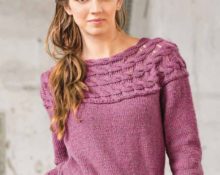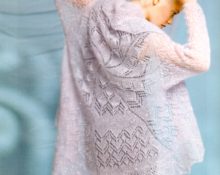 An openwork pullover is always a difficult knitting or crocheting project. Moreover, one incorrectly executed loop can damage the entire motif. Nevertheless, the result of this painstaking, patience-requiring handicraft will eclipse all the difficulties of its production. An item with openwork motifs in different variations can fit into any look.
An openwork pullover is always a difficult knitting or crocheting project. Moreover, one incorrectly executed loop can damage the entire motif. Nevertheless, the result of this painstaking, patience-requiring handicraft will eclipse all the difficulties of its production. An item with openwork motifs in different variations can fit into any look.
Knitting openwork pullovers
An openwork pullover knitted with your own hands always outperforms something bought in a store. In addition to the fact that as a result of knitting you will receive an exclusive item in a single copy, it will also carry your energy charge.
Reference! Even the world cinema star, the owner of a slender figure, Julia Roberts, not only likes to add a knitted sweater to her outfit, but is not averse to knitting one herself.

Modern fashionistas are also pleased that such an interesting trend can be afforded by a person of any income. After all, most blouses with an openwork pattern can be created independently.And the hook or knitting needles are up to the craftswoman to choose.
There are many different variations of pullover models - with a yoke, raglan, but a less experienced knitter should choose a simpler pattern.
Openwork summer knitted pullover
An openwork summer pullover can be knitted in a couple of days.

This model will easily fit into everyday casual style. Convenient, practical and stylish! Most girls from teenagers to mature women prefer this style.
Materials and tools
It is better to buy knitting needles and yarn in the same store, along with consultation from the seller. If you are a beginner, the seller will recommend his number for each type of yarn.
Important! Knitting needles should be chosen slightly thicker than the yarn itself.
You need to pay attention to the knitting needles: depending on the product, they may be different. Larger items will require long knitting needles. For socks it is better to take special stockings. But there are also special knitting needles that are connected to each other (chain or thick fishing line) - they are suitable for particularly large work. The product will not fly off them in any case.
For knitting we will need:
- knitting needles number 6, circular knitting needles of the same number;
- black yarn (100% silk, 100 m/50 g) - 450 (or 550) g.
Pullover pattern and knitting patterns
The product is designed for sizes 38/40 (46/48). The number in brackets next to the pattern refers to size 46/48. Before brackets - the number that will refer to size 38/40.
 Pattern
Pattern

When making an openwork pattern, you need to start by counting the loops. In this pattern, the number of loops must be made a multiple of 16+1+2. Knit according to the pattern presented in the description; both the front and back rows are indicated there.
You need to start with the edge loop and all the indicated repeat loops.Next, repeat the repeat as much as needed in size and finish with loops after the repeat according to the pattern. Make one last edge. Repeat the repeat motifs (that is, from rows 1 to 12 of the pattern) to the desired level.
Important! If increases or decreases are planned, then they should be carried out adhering to the main rule - the number of stitches knitted together and yarn overs must match within the row.
Description of knitting stages
Stage 1: back
On needles number 6 you need to cast on 99 (115) stitches and make a purl row with the front ones. Next, go straight to the main pattern.
- Knit 35.5 cm (this corresponds to 66 rows) - cast off 7 loops for the armholes. This will leave 85 (101) stitches on the needles.
- At the level of 52 cm (this corresponds to 96 rows) for a larger size 57 cm and this is already 106 rows - bind off all the loops.
Attention! You can immediately mark the loops for the neckline - these are the middle ones and for the shoulders (20 (28) loops each) using knitting markers.
Stage 2: before
Proceed similarly to the back, and then for the neckline at a height of 42 (47) cm or in the 78 (88) row, bind off the middle 33 loops. After closing, knit both sides separately.
For a smooth rounding, close the inner edge of the loop as follows:
- first - in every second there are 2 loops (so 2 times);
- after - in every second 1 loop (so 2 times).
When the height is equal to the height of the back, you will need to close the remaining 20 (respectively 28) loops for the shoulders.
Stage 3: sleeves
- For the sleeve you will need to cast on 51 (67) stitches using size 6 needles.
- The first row will be the wrong side right away - work it with facial loops.
- Go to the main pattern. Knit to a height of 29 cm (this corresponds to row 54).
- Close all loops without any gaps.
Stage 4: assembly
The assembly differs little from the assembly of other sweaters:
- make shoulder seams;
- Using circular knitting needles, cast on 93 stitches from the edge of the neckline and make just one row with purl stitches, but bind off the loops as purl stitches;
- sew in the sleeves (they will need to be pulled slightly);
- make side seams;
- sew the sleeve seams.
The product is ready, you can hide the threads and try on the next elegant thing on your body.


 0
0





